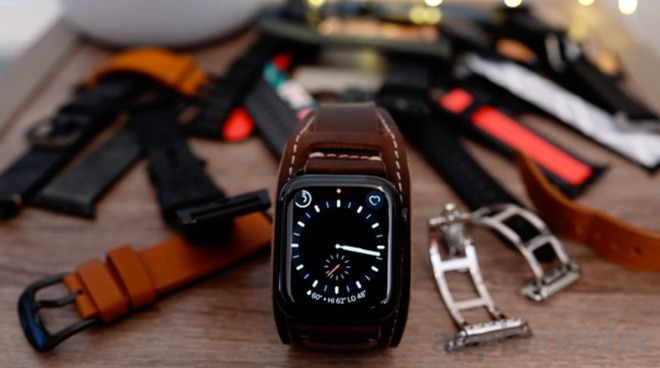The Apple Watch could include a system for automatically keeping the band tight around the wrist of the wearer in the future, one that could keep the band at a tension that is optimal for biometric readings while still maintaining user comfort.

The Apple Watch includes a sensor on the back that is used for two main purposes. Primarily it is employed to monitor the wearer's heart rate over time using optical means, while newer models like the Apple Watch Series 4 and Series 5 include ECG capabilities that use both the sensor and the Digital Crown.
To make sure the sensor performs properly, it needs to be in contact with the skin and at an appropriate pressure. Too much pressure and it becomes uncomfortable to wear, while too little will mean there are periods when it isn't in contact and incapable of making a reading.
As a byproduct, the security features of the Apple Watch allows it to be open for interactions when it is unlocked and in maintained contact with the user's skin, but automatically locks when it is removed from the wrist. By wearing the Apple Watch too loosely, this could inadvertently lock the device despite being worn consistently throughout the day.
Current band mechanisms fix the effective circumference of the loop at a point of the user's choosing, and typically without any elastication used. This fixed nature also means if a user bends their wrist in some ways, this could make wearing the Apple Watch uncomfortable for brief periods, and potentially risk breaking the band itself in certain circumstances.
In a patent granted to Apple on Tuesday by the U.S. Patent and Trademark Office titled "Consistently-tight watch band," Apple proposes the use of a watch band that can accommodate changes in the size and circumference of a user's wrist as they move it. By maintaining a specific level of pressure despite the user's movements, this can help make the band as comfortable as possible to wear, while maintaining the Apple Watch's functionality.
According to the filing, the band could contain opposing spring segments at a pivot point, as part of a number of compliant mechanisms throughout the band itself. The segments are able to extend and contract between two positions, with the springs keeping the band at a desired level of tightness throughout its motions.
An example of the patent's watch band, using a repeated spring pattern throughout its design
In short, the mechanisms increase the length of the band when the wrist circumference increases during movement. When the wrist circumference shrinks down, the mechanisms revert back to their previous form.
While such a system could have a series of mechanisms running along the length of the band that react in the same way at the same time, it may be possible for the mechanisms to open up sequentially, with some areas opening up before others do so. This could be made so that more resilient parts of the band could be opened up before more delicate regions at the extreme ends or near the coupling mechanism are employed.
This effect could be produced by using a repetitive string of the mechanisms, but using varying spring strengths. Apple also suggests the use of mechanisms with "lower spring constants" in some areas to make them more susceptible to being used over versions in other band regions.
As part of the claims, Apple suggests the bands could also be configured to maintain a constant width despite the movement of mechanisms, minimizing the appearance of the band "stretching" and eliminating the thinning effect of conventional material stretching. Apple also suggests the bands could be formed monolithically of an elastomer, simplifying the construction.
An illustration of how the band could extend in length using the spring and pivot system while still maintaining the band's width
Apple files numerous patent applications on a weekly basis, but while the patents aren't a guarantee that the idea will make their way into a future product or service, they do demonstrate areas of interest for Apple's research and development teams.
Unlike many other Apple Watch-related patent filings, the ideas described are something that Apple could implement quite quickly, as it involves a type of strap rather than anything requiring major changes to the construction of the Apple Watch itself. It wouldn't be unreasonable for Apple to create and market a band based on the patent quite quickly, in theory.
This is not the first attempt by Apple to solve the tensioning problem. One patent granted in 2017 for a "Dynamic fit adjustment for wearable electronic devices" explained how an onboard tensioner could automatically change the length of the band on the fly, though it would require a redesign of the Apple Watch to put into practice.
Apple's work exploring the utility of the Apple Watch bands has extended to areas like adding components to the band and electronically connecting it to the Apple Watch via the existing coupling mechanism, adding light-up indicators to the band, hiding components in bracelet links, and even including a band-based camera.
A more recent patent application from October titled "Fabric-based items with strechable bands" suggested the use of elasticated bands embedded with components connected with conductive strands, but not just for Watch bands. The filing suggested it could include wearable items like a hat, undergarments, or other athletic attire.


